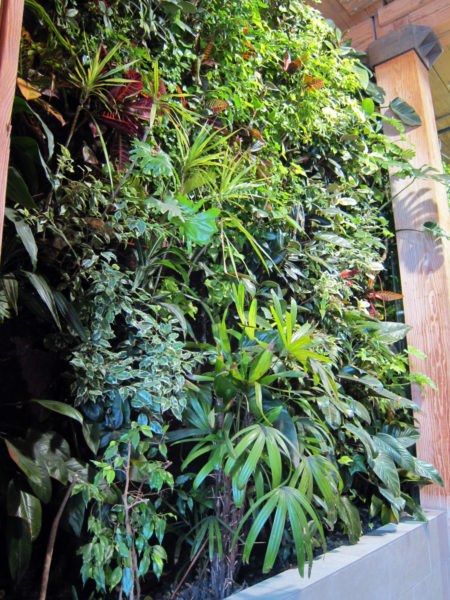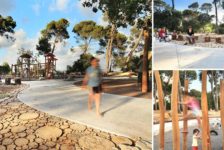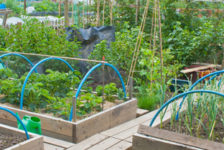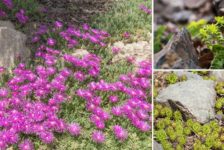Robertson Building Biofilter by Nedlaw. Image © Tamara Urben-Imbeault
Biofilters are a relatively new and innovative technology in the world of vertical gardens that combine the fields of landscape architecture, building architecture and horticultural science. A biofilter is broadly defined as a hydroponic vertical garden that has been designed to pull air through the growing medium to filter it. (See the previous post “A History of Vertical Gardens from Simple Vines to Hydroponic Systems” for more information about different types of vertical gardens). By passing through the felt growing medium, microbes on the plant roots can filter out up to 85% of the harmful Volatile Organic Compounds (VOCs) from of the air. These gardens can be independent of, or built into, a building’s HVAC system.
 Nedlaw Living Wall at Drexel. Image courtesy of Nedlaw Living Walls.
Nedlaw Living Wall at Drexel. Image courtesy of Nedlaw Living Walls.
The first biofilter was designed and built at the University of Guelph Humber in Toronto, Ontario, Canada, as a collaboration between then-student Alan Darlington, and Diamond Schmitt Architects. The goal of the project was to showcase the research that was being done by Darlington and others at the school as a part of NASA’s Advanced Life Support Program. The system, installed in an atrium at the Toronto campus, is now 10 years old and continues to be an integral part of research projects on the topic. Studies of the wall have proven that reductions in levels of toluene, dust, and airborne fungal spores result from the installation of a biofilter. One of the big advantages of this system is that no toxic waste by-products are created through the filtering process. The use of an open air hydroponic system exposes microbes present around plant roots which feed off of harmful VOCs, removing up to 85% of them in a single pass.
 Dr. Alan Darlington with the Nedlaw system at the Sun Life Financial Building in Toronto, August 2013. Image ©Tamara Urben-Imbeault
Dr. Alan Darlington with the Nedlaw system at the Sun Life Financial Building in Toronto, August 2013. Image ©Tamara Urben-Imbeault
Most of the plants used in biofiltration are tropical plants commonly found in homes around North America such as Ficus benjamina; Philodendron selluom; Umbrella Plant, Shefflera arboricola; Rubber Plant, Ficus elastica; Dracaena spp.; and Ivy, Hedera algeriensis, among others. Biofilters, like all other hydroponic walls, are planted with plants that have already been started in a greenhouse, so the result is immediate. As with all living landscapes, die off and disease do sometimes occur, so regular maintenance is necessary. Depending on the types of plants used, and their propensity for disease, 90% of the plants will usually establish themselves successfully. On average, monthly maintenance is recommended to check plants for disease and die off, and weekly checks are necessary to ensure the irrigation system is functioning normally. That said, the manufacturer recommended maintenance schedule must be followed to ensure longevity.
 Close up of Nedlaw’s Leamington Living Wall. Image courtesy of Nedlaw Living Walls.
Close up of Nedlaw’s Leamington Living Wall. Image courtesy of Nedlaw Living Walls.
Biofilters can significantly contribute to the betterment of people’s health. Various studies have proven that living walls promote increased productivity, reduced sick days, give a better sense of well being in employees, lower blood pressure and increase positive feelings. Views to parks or green space have been proven to reduce recovery time for hospitalized patients, and it is assumed that similar outcomes would result from views that include green walls.
 Image courtesy of Nedlaw Living Walls.
Image courtesy of Nedlaw Living Walls.
Biofilter quotes are available through Nedlaw Living Walls and are custom for each project.
Stay tuned for the next post in our Vertical Gardening Series, where I share some gardens that I believe are some of the most innovative projects from around the world!
Credits:
Leading image: Robertson Building Biofilter by Nedlaw. © Tamara Urben-Imbeault
Written by Tamara Urben-Imbeault, M.L.Arch. student at the University of Manitoba, Winnipeg, Manitoba, Canada. She is currently working on her design thesis entitled “Vertical Gardening in Cold Weather Climates”
Contact: umurbeni[at]myumanitoba.ca or t.urbendesign[at]gmail.com
Sources:
Banting, D., Doshi, P.H., Li, D.J., Missios, D.P., Au, A., Currie, B.A., Verrati, M., (2005.) Report on the Environmental Benefits and Costs of Green Roof Technology for the City of Toronto. City of Toronto and Ontario Centres of Excellence – Earth and Environmental Technologies (OCE-ETech), Toronto, Ontario,
Beatley, Timothy. (2011). Biophilic Cities. Washington: Island Press.
Diamond Schmitt Architects (2014). Living Wall Biofilter Turns 10. Diamond Schmitt Architects: News. Retrieved from http://www.dsai.ca/news/living-wall-biofilter-turns-ten
Green Over Grey (2009). Indoor Air Quality. Retrieved from: http://greenovergrey.com/green-wall-benefits/indoor-air-quality.php
Green Roofs for Healthy Cities, GRHC (2010) Green Walls 101: Systems Overview and Design Second Edition Participant’s Manual. Green Roofs for Healthy Cities.
Hum, Ryan and Lai, Pearl (2007) Assessment of Biowalls: An Overview of Plant-and-Microbiral-based Indoor Air Purification System. Physical Plant Services, Queen’s University. Retrieved from https://www.google.ca/url?sa=t&rct=j&q=&esrc=s&source=web&cd=1&cad=rja&ved=0CDAQFjAA&url=http%3A%2F%2Fwww.queensu.ca%2Fpps%2Freports%2Fbiowalls.pdf&ei=aZeRUaOiCq7TigKu54DwBQ&usg=AFQjCNEnv_PyXnqBCiam0bR8331xr8epNA&sig2=KgN9f25OJGLCYJrW9zAFBQ&bvm=bv.46471029,d.cGE
Kaplan, Rachel (1993). The Role of Nature in the Context of the Workplace. Landscape and urban planning 26 (1): 193–201.
Miflin, Claire (2007). Vegetation in Architecture. The American Institute of Architects. Posted April 17, 2008: http://www.aia.org/akr/Resources/Documents/AIAP037639?dvid=&recspec=AIAP037639
Nedlaw Living Walls (2011). Retrieved from http://www.naturaire.com/
Ulrich, R.S. (1984). View Through a Window May Influence Recovery from Surgery. Science Magazine. Vol 224, no. 4647.
Vowles, Andrew (2004). Guelph-Humber Plant Wall A Breath of Fresh Air. Retrieved from: http://www.uoguelph.ca/atguelph/04-11-10/featuresair.shtml
Published in Blog











Mọt Gỗ
I like Vertical Garden in pic 2. Luxury garden!